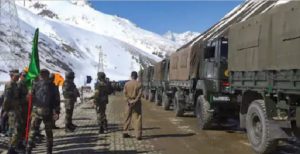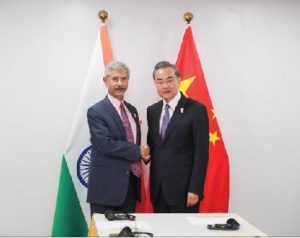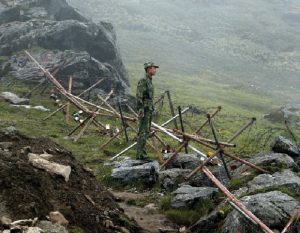 Since May, when the border row started, India has held diplomatic engagement with China and matched troop deployment along the Line of Actual Control (LAC) in eastern Ladakh to counter Chinese aggression. India even took a slew of tough economic measures aimed at hurting Chinese business interests but the dispute remains unresolved.
Since May, when the border row started, India has held diplomatic engagement with China and matched troop deployment along the Line of Actual Control (LAC) in eastern Ladakh to counter Chinese aggression. India even took a slew of tough economic measures aimed at hurting Chinese business interests but the dispute remains unresolved.
Instead, China seems to be in a mood to prolong the confrontation. This view is backed by the fact that several rounds of talks between the diplomats and senior military commanders of the two countries, including high-level parleys between the India and China foreign and defence ministers, have failed to produce any tangible results.
The latest in the series is the five-point peace agenda that India’s External Affairs Minister Dr. S. Jaishankar worked out with State Councillor and Foreign Minister of China Wang Yi in Moscow on September 10 on the sidelines of the Shanghai Cooperation Organisation (SCO) conclave which had raised hopes of a solution but its real test lies in how China rolls out the peace process on the ground.
Earlier, the high-level meeting between Indian Defence Minister Rajnath Singh and State Councillor and Defence Minister of China General Fenghe Wei on September 4 in Moscow on the sidelines of a SCO meeting too had generated hopes of a truce but did not bring any solution.
As Singh asked his Chinese counterpart to respect the LAC, Beijing responded by saying it was not prepared to lose even an inch of territory.
Before Dr Jaishankar flew to Moscow, he noted the eastern Ladakh border situation is far more serious than 1962 when India and China fought a war in the Galwan Valley area.
 After Dr Jaishankar held a separate meeting with his Chinese counterpart, a statement from India’s external affairs ministry said that both sides should take guidance from the series of consensus of the leaders on developing India-China relations, including not allowing differences to become disputes.
After Dr Jaishankar held a separate meeting with his Chinese counterpart, a statement from India’s external affairs ministry said that both sides should take guidance from the series of consensus of the leaders on developing India-China relations, including not allowing differences to become disputes.
The two Foreign Ministers noted the current situation in the border areas is not in the interest of either side and agreed that the border troops of both sides should continue their dialogue, quickly disengage, maintain proper distance and ease tensions.
The two Foreign Ministers also agreed to abide by all the existing agreements and protocol on China-India boundary affairs, maintain peace and tranquillity in the border areas and avoid any action that could escalate matters.
The Foreign Ministers further agreed that as the situation eases, the two sides should expedite work to conclude new Confidence Building Measures to maintain and enhance peace and tranquillity in the border areas.
However, that sounds like a pipe dream given China’s stubbornness in implementing any earlier peace negotiations between diplomats and military commanders of the two countries on the ground and its continuous efforts to mobilize troops and armaments along the LAC in a clear sign of escalation.
In his meeting with Yi, Dr Jaishankar expressed strong concern that such a large concentration of troops was not in accordance with the 1993 and 1996 Border Agreements between the two countries and created flash points along the LAC.
The Chinese side has not provided a credible explanation for the troop deployment, Dr Jaishankar noted as he pointed out that the provocative behaviour of Chinese frontline troops at numerous incidents of friction along the LAC showed disregard for bilateral agreements and protocols.
India conveyed that it expected full adherence to all agreements on management of border areas and would not countenance any attempt to change the LAC status quo unilaterally.
Dr Jaishankar emphasized that the Indian troops have scrupulously followed all agreements and protocols pertaining to the management of the border areas and noted the immediate task is to ensure a comprehensive disengagement of troops in all the friction areas.
This, he said, is necessary to prevent any untoward incident in the future and noted that the final disposition of the troop deployment to their permanent posts and the phasing of the process is to be worked out by the military commanders.
The reality is both the armies face each other along the LAC.
Another high point in the ongoing India-China border row came when Defence Minister Rajnath Singh decided to brief the Indian Parliament on the worst standoff the two countries have seen in several decades.
 Realizing it could no longer avoid speaking on the border row as an angry Opposition demanded a statement from the PM, who had earlier said there is no intrusion, the centre fielded Rajnath Singh, who gave a long speech in the Lok Sabha on Sep 15 but in essence reiterated that India wanted peace but was prepared for any contingency.
Realizing it could no longer avoid speaking on the border row as an angry Opposition demanded a statement from the PM, who had earlier said there is no intrusion, the centre fielded Rajnath Singh, who gave a long speech in the Lok Sabha on Sep 15 but in essence reiterated that India wanted peace but was prepared for any contingency.
That contingency, which effectively means a limited military conflict, is the last thing India would want at a time when the country is dealing with the Covid-19 pandemic and a sunken economy. China knows this and is therefore interested in prolonging the border standoff which has been forced upon India.
In his speech, Singh articulated the existing positions and gave a background to the long-standing border question with China as he urged the parties across the political spectrum to unitedly back the Indian Army which is regularly gaining strategic heights along the LAC to counter any misadventure from the Chinese People’s Liberation Army.
“India and China are yet to resolve their boundary question. China does not accept the customary and traditional alignment of the boundary between India and China. We believe that this alignment is based on well-established geographical principles confirmed by treaties and agreements, as well as historical usage and practice, well-known for centuries to both sides. The Chinese position, however, is that the boundary between the two countries has not been formally delimited, that there exists a traditional customary line formed by the extent of jurisdiction that they claim was exercised historically by each side, and that the two sides have different interpretations of the position of the traditional customary line,” said Singh.
These facts are not new and have in a way given the Opposition a chance to target the centre over lack of strategic clarity which is reflected in the initial denial of any intrusion from China but was later responded with some tough talking in Ladakh and in New Delhi. The approach is also reflected in lengthy explanations on how negotiations were being held to resolve the matter peacefully to warn that India will never compromise over its integrity.
On the economic front too, decoupling of the India-China business is easier said than done despite a ban on over 200 Apps and restrictions imposed in key infrastructure projects even as Chinese companies launch new mobile phones in the Indian market.
The Congress party, which has been questioning the centre’s China policy since May, attacked the Modi government over its dilly dalliance. A day after Rajnath Singh’s speech, Congress leader Rahul Gandhi said on Sep 16.
“Understand the chronology: PM said- no one crossed the border. Then, took a huge loan from a China-based bank Then, Def Min said- China occupied our land. Now, MOS Home says- there’s no infiltration. Is Modi Govt with Indian Army or with China? Modi ji, why so scared?”
On Sep 11 he tweeted. “The only “talk” to have with China is about restoration of ‘Status Quo Ante’ as of March 2020. PM & GOI refuse to take responsibility for pushing China out of our land. All other “talk” is worthless.”
“The Chinese have taken our land. When exactly is GOI planning to get it back? Or is that also going to be left to an ‘Act of God’?”
On his part, Rajnath Singh told the Lok Sabha that the China-India border row is a vexed issue and that the two countries had engaged in discussions during 1950s-60s but the efforts did not yield a mutually acceptable solution.
As of now, China continues to be in illegal occupation of approximately 38,000 sq. km in the Indian Union Territory of Ladakh. In addition, under the so-called Sino-Pakistan ‘Boundary Agreement’ of 1963, Pakistan illegally ceded 5,180 sq. km. of Indian territory in Pakistan Occupied Kashmir to China. China also claims approximately 90,000 sq. km of Indian territory in the Eastern Sector of the India-China boundary in Arunachal Pradesh. According to Singh, both India and China have formally agreed that the boundary question requires patience and have committed to seeking a fair, reasonable and mutually acceptable solution through dialogue and peaceful negotiations.
The two sides also agree that maintenance of peace and tranquility in the border areas is an essential basis for the further development of bilateral relations.
“I would like to mention here that as yet there is no commonly delineated Line of Actual Control (LAC) in the border areas between India and China and there is no common perception of the entire LAC. Therefore, in order to ensure peace and tranquility in the border areas, especially along the Line of Actual Control (LAC), the two countries have concluded a number of agreements and protocols,” said Singh.
Under these agreements, the two sides have agreed to maintain peace and tranquility along the LAC without prejudice to their respective positions on the alignment of the LAC as well as on the boundary question.
It is on this basis, that overall India-China relations saw considerable progress since 1988.
India’s position is that while bilateral relations can continue to develop in parallel with discussions on resolving the boundary question, any serious disturbance in peace and tranquility along the LAC in the border areas is bound to have implications for the positive direction of the bilateral ties.
Singh pointed out that a key element of both the 1993 and the 1996 Agreements is that the two sides will keep their military forces in the areas along the Line of Actual Control to a minimum level, something which China violated in April.
“In late 1990s and up to 2003, the two sides engaged in an exercise to clarify and confirm the LAC. But, thereafter the Chinese side did not show a willingness to pursue the LAC clarification exercise. As a result, there are some areas where the Chinese and Indian perceptions of LAC overlap. In these areas, as also with other sections of the border areas, the various agreements govern the manner in which troops of both sides should operate and deal with situations of face-offs to maintain peace and tranquillity,” he said.
The Indian defence minister mentioned the June 15 clashes in the Galwan Valley which took away the lives of 20 Indian soldiers and claimed the lives of around 40 PLA troops though China is mum over the figure. “The Chinese side created a violent face off on June 15th at Galwan. Our brave soldiers laid down their lives and also inflicted costs including casualties on the Chinese side,” said Singh. Another faceoff he said was also rebutted by the Indian forces. “Even as discussions were going on, the Chinese side again engaged in provocative military manoeuvres on the night of August 29 and 30 in an attempt to change the status quo in the South Bank area of Pangong Lake. But yet again, timely and firm actions by our armed forces along the LAC prevented such attempts from succeeding,” said Singh.
The situation in 2020 is very different both in terms of scale of troops involved and the number of friction points. The Chinese side has mobilized a large number of troops and armaments along the LAC as well as in the depth areas. There are several friction areas in Eastern Ladakh including Gogra, Kongka La and North and South Banks of the Pangong Lake.
China which has undertaken significant infrastructure construction activity that enhanced their deployment capabilities in the border areas is worried as India too has stepped up the budget for more roads and bridges in the border areas.
With no warmth left in the India-China relations, the Indian Army is preparing for a long haul and tough winters in eastern Ladakh. The Indian troops are capable of serving at forbidding altitudes with scarce oxygen and in extremely cold temperatures, something they have effortlessly done over the last many years in areas like Siachen and Kargil.
letters@tehelka.com










